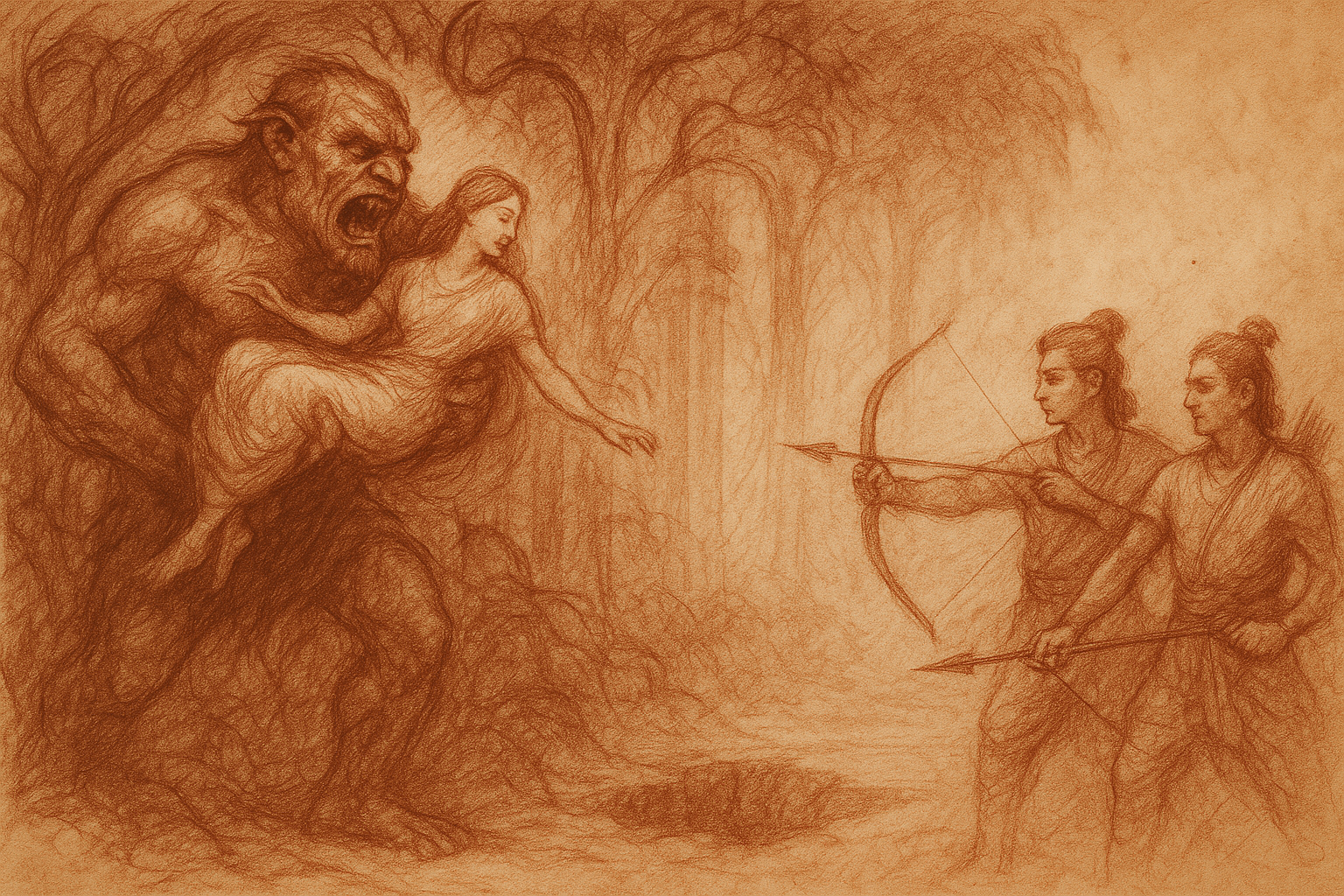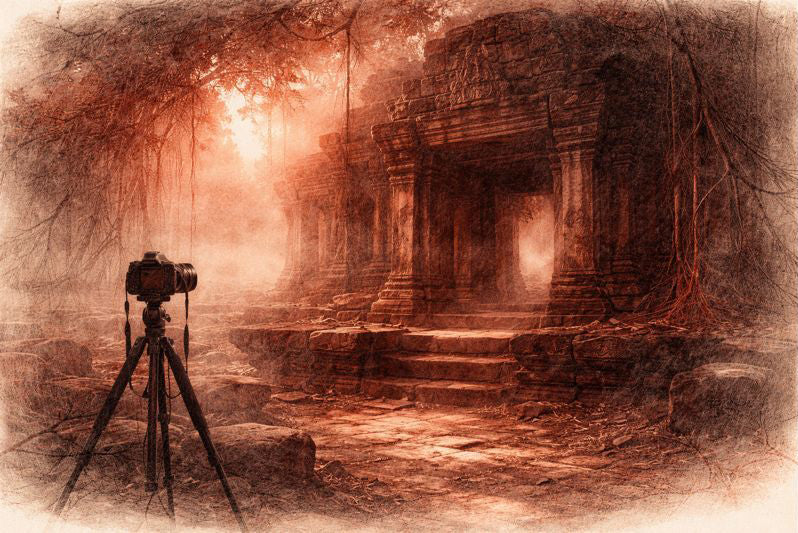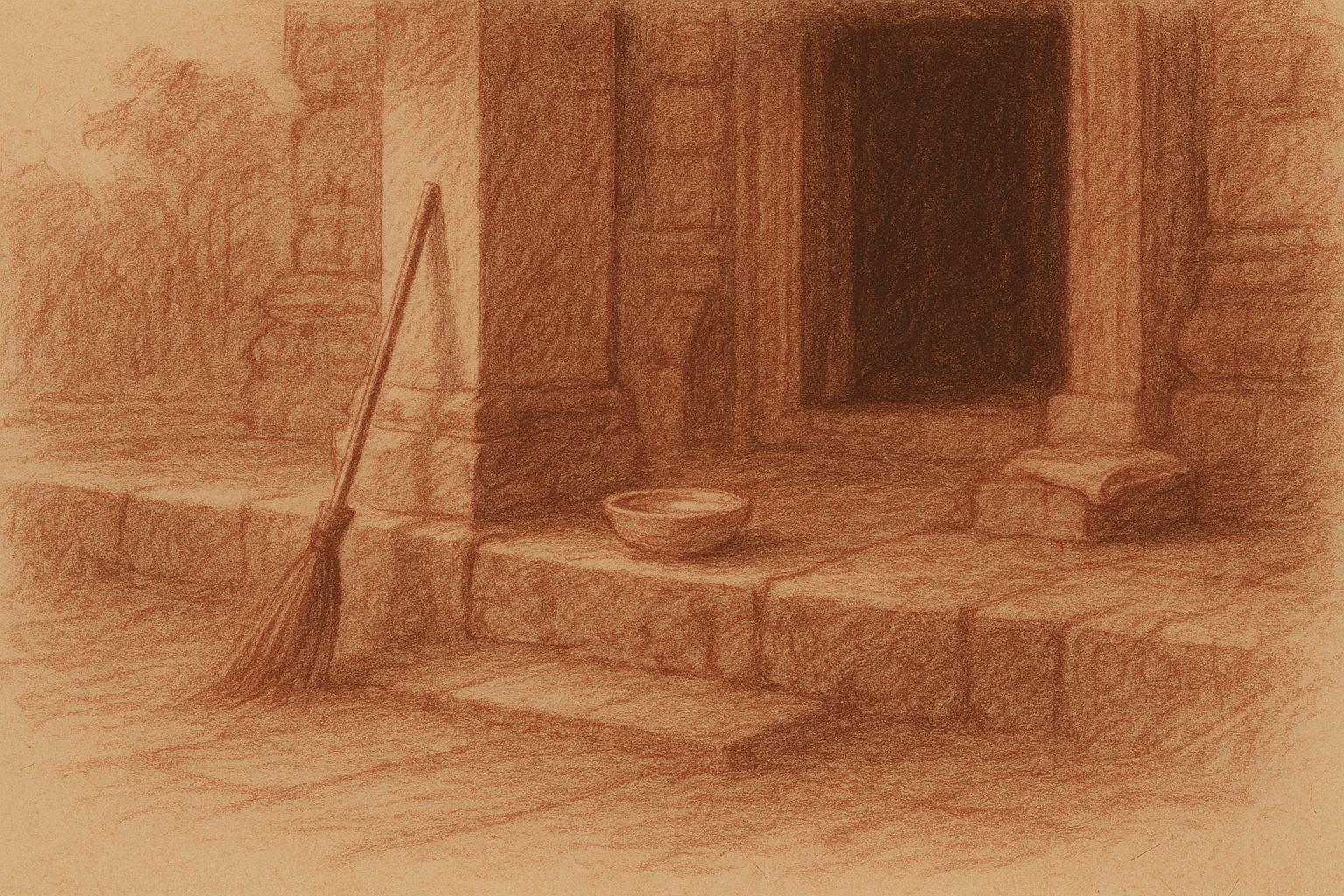Complimentary worldwide shipping on orders over $400 · No import tariffs for most countries
Complimentary worldwide shipping on orders over $400 · No import tariffs for most countries

The Demon Who Could Not Devour Her
3 min read
Sanctuary of Meaning · Artist’s Journal
“He came from shadow, howling,
but could not hold the light.”
—from a field note in the southern galleries of Banteay Srei
—
There is a silence beneath the carvings where story and stone meet. In that silence, the Ramayana is not merely remembered—it is re-lived.
Among the sacred red sands of Banteay Srei, deep within the jungle’s breath, a single lintel speaks with the voice of thunder. It tells of an early moment in exile, when Rama, Sita, and Lakshmana wandered the wild Dandaka forest, unaware that fate’s long arc had begun to rise. They had left behind a kingdom. But the gods, it seemed, had not yet left them.
Out of the darkness came Viradha.
He was no ordinary rakshasa. The text calls him “sunken-eyed, hugemouthed, pointed-eared… belly deformed.” A grotesque form, clad in tiger skin, smeared with blood, howling through the trees. He seized Sita—luminous, unarmed Sita—and hoisted her onto his shoulder like a war trophy, declaring himself her husband-to-be, and the brothers his prey.
The lintel captures it all: her slight, graceful figure caught in the grasp of the monstrous Viradha, Rama and Lakshmana flanking the scene—bowstrings drawn, faces intent. There is no motion in stone, and yet the carving ripples with urgency, with sorrow, with the tremor of a vow soon to be spoken across kingdoms.

On a lintel at Banteay Srei Temple, the demon storms forward, bearing Sita high on his shoulder—yet all around her, the forest itself seems to recoil.
The Aranya Kanda tells how Rama’s arrows flew first—seven flaming shafts of divine light. They struck, but Viradha did not fall. Shielded by a boon from Brahma, his monstrous body expelled the weapons as if they were mist. Still roaring, he surged forward, immune to pain, invincible to earthly steel.
And yet—he could not withstand their hands.
Rama shattered his right arm. Lakshmana crushed the left. Together, they cast him down like a fallen tree. They could not kill him by force. But they could bury him.
Only then, in defeat, did the truth surface. The rakshasa revealed his hidden form: a gandharva named Tumburu, once celestial, cursed by Kubera for a forbidden love. His penance was to dwell in shadow until slain—not by weapon, but by ritual burial. And so, with reverence for his sorrow, the brothers dug a pit and laid him to rest. It was not an execution, but a release.

Even in stone, her face turns away. Even in stone, the forest holds its breath.
This is the Ramayana as Angkor remembers it: not as conquest or spectacle, but as sacred drama—threads of karma, curse, and grace woven into the quiet of stone. Viradha, terrible as he was, became a vessel for redemption. Sita, though nearly taken, was never truly lost. And the forest—dense, ancient, and breathing—was witness to it all.
We find the story again, carved high upon the pediments of Angkor Wat. The demon reappears—not as memory, but as echo—still drawn toward what he cannot possess, still burning with the grief of his exile.
Angkor Wat Templ
High upon an eastern pediment at Angkor Wat Temple, the demon returns—but this time, light pierces the battle from behind the clouds.
The telling shifts subtly. At Angkor Wat, the scene becomes more tempestuous—Rama and Lakshmana unleash a storm of arrows, Viradha howls, Sita hovers on the brink. The weapons multiply. The wounds deepen. But still, no blade can deliver the final blow.
Only when the brothers abandon violence and listen—only when they bury him—does the tale find rest.
This is a recurring truth in the Khmer Ramayana: that power alone does not redeem. It is discernment, compassion, and the fulfilment of dharma that restore the sacred order.
What cannot be destroyed
must be released into earth—
a vow buried whole.
From this moment forward, the Ramayana turns. This is not the famed abduction by Ravana—that dark spiral into war—but a foreshadowing. A warning in the woods. A whisper that even the divine will know suffering. That sometimes, the fiercest battles must be laid to rest—not vanquished, but understood.
In Khmer stone, this story remains a fragment. But to those who walk slowly, who listen with the inner ear, it is more than enough.
It reminds us: even monsters may once have been stars. And the earth, in her silence, still remembers how to forgive.
—
The one who came to devour her became the one delivered, and the forest closed its mouth around the tale.
—
Also in Library

Before the Shutter Falls
3 min read
Before the shutter falls, fear sharpens and doubt measures the cost of waiting. In the quiet hours before dawn, the act of not-yet-beginning becomes a discipline of attention. This essay reflects on patience, restraint, and the quiet mercy that arrives when outcome loosens its hold.

Those Who Keep the Way Open — On the Quiet Guardians of Angkor’s Thresholds
3 min read
Quiet gestures shape the way into Angkor — a swept stone, a refilled bowl, a hand steadying a guardian lion. This essay reflects on the unseen custodians whose daily care keeps the thresholds open, revealing how sacredness endures not through stone alone, but through those who tend its meaning.

Multiplicity and Mercy — The Face Towers of Jayavarman VII
5 min read
A new vision of kingship rises at the Bayon: serene faces turned to every horizon, shaping a world where authority is expressed as care. Moving through the terraces, one enters a field of steady, compassionate presence — a landscape where stone, light, and time teach through quiet attention.
Join My Studio Journal
Receive occasional letters from my studio in Siem Reap—offering a glimpse into my creative process, early access to new fine art prints, field notes from the temples of Angkor, exhibition announcements, and reflections on beauty, impermanence, and the spirit of place.
No noise. No clutter. Just quiet inspiration, delivered gently.
Subscribe and stay connected to the unfolding story.

Join My Studio Journal
Receive occasional letters from my studio in Siem Reap—offering a glimpse into my creative process, early access to new fine art prints, field notes from the temples of Angkor, exhibition announcements, and reflections on beauty, impermanence, and the spirit of place.
No noise. No clutter. Just quiet inspiration, delivered gently.
Subscribe and stay connected to the unfolding story.
